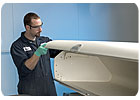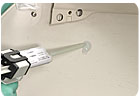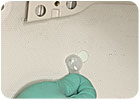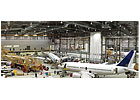

Among the newest products now used at Cascade is a Huntsman Advanced Materials bromine-free, flame-retardant epoxy syntactic that produces high-strength reinforcement of fasteners installed in overhead baggage bins and other honeycomb core parts. Cascade made the change to Epocast®1633-A41/B low-density epoxy syntactic in response to the latest environmental standards governing formulations used in flame-retardant epoxies. The lightweight syntactic is the product of several years of research aimed at eliminating the chemical components octabromodiphenyl ether (OBDE) and/or pentabromodiphenyl ether (PBDE) that have been used to produce flame-retardant compounds. In addition to featuring sound environmental characteristics, the syntactic products exhibit a compressive strength of 6,500 psi and are qualified to Boeing BMS 5-28, Type 18, Class 2 as well as Airbus AIMS 08-08-001-04 specifications. The syntactic used at Cascade is gray, but the material is available in light blue, orange and black formulations as well.
Cascade selected the new low-density epoxy syntactic as one of the many materials it uses to support the company’s operating philosophy (to sustain strong business growth by providing customers with the highest quality and reliability in its repairs). The continuing success of the MRO during its more than 30 years in the industry attests to the success of its philosophy. Cascade today has the newest maintenance facility in North America. Built specifically for working on the narrow-body passenger and transport aircraft that form the mainstay of its business, the world-class building covers 250,000 square feet and has eight bays for aircraft.

Baggage Bin Reinforcement
Among the aircraft parts that most often need repair are overhead baggage bins. The bins are frequently punctured or crushed when passengers load and unload luggage. Damage is found when bins are removed for “C” checks - when an aircraft is stripped down to the fuselage for inspection. While bin repairs are cosmetic, airlines strive to maintain interiors that are aesthetically pleasing to passengers.As part of its completion steps on refurbished bins, Cascade reinforces honeycomb core at points that will be used to mount the bin in the aircraft. Technicians begin by drilling a hole for the insert and then wiping down the area to remove debris. A 50-ml dual-barrel cartridge containing pre-measured amounts of Epocast 1633 is then installed in a manual dispensing gun. Next, a tabbed insert is placed over the cavity and the technician pulls the gun trigger to dispense mixed resin and hardener into the first side of the tab. The technician continues adding syntactic until the material flows from the second side of the tab, indicating that the cavity is full and the reinforcement complete. The cartridges used for the epoxy syntactic provide for thorough mixing and neat dispensing through disposable static mix nozzles. The packages also minimize material waste because cartridges can be resealed and used again by simply installing a new nozzle.
The 45 lbs./ft.3density Epocast 1633-A41/B epoxy syntactic has an extrudable paste viscosity and a 2-5-minute work life. The material sets quickly at room temperature to increase productivity. After the syntactic cures, the tabbed section is removed, excess epoxy is sanded off, the bin door is reinstalled and the unit is repainted before it is put back on the aircraft.
